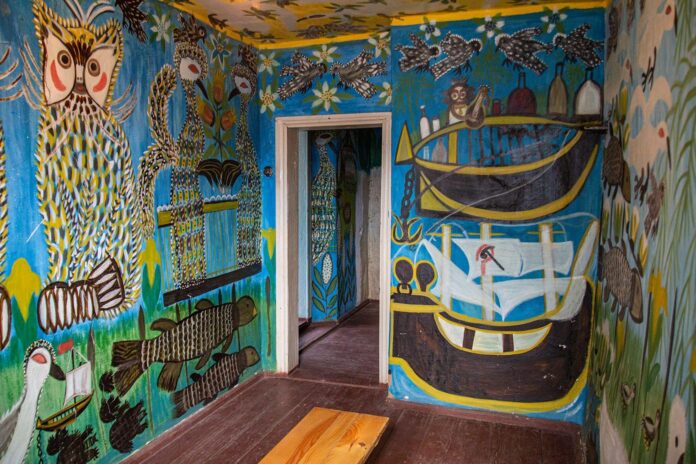Floodwater from the breached Nova Kakhovka Dam in the Russian-occupied Kherson province of southern Ukraine is said to have submerged the house museum of the late, self-taught Ukrainian artist Polina Rayko. The dam collapsed on Tuesday, devastating the region and prompting fears of a humanitarian disaster. At least eight people have died from flooding in the region so far, according to both Ukrainian and Russian officials.
On Tuesday the Ukraine army’s southern military command alleged that Russian forces blew up the dam; Ukrainian president Zelensky later accused Russia of committing ecocide. Meanwhile, the local Russian-installed mayor has called it a “terrorist act”. Investigations into the cause of the dam collapse are ongoing.
The museum, in Rayko’s hometown of Oleshky, contains decades of work by the artist, who overcame personal tragedy by painting fantastical visions of flora and fauna across the surfaces of her home. A video interview with Rayko in 2003, one year before her death, shows extensive footage of the house.
“As of now (7/6/23 6:00 p.m.), I know that the house with the frescoes is under water,” wrote Simon Khramtsov, the head of a foundation that promotes Rayko’s heritage,in a Facebook post.
As floodwaters closed in on Oleshky, the Ukrainian art historian Oksana Semenik wrote of the museum on Twitter: “The walls, ceilings, doors of a six-room house, gates, fences, and garage gates served as canvases for the rural artist. Polina Rayko loved to draw birds of different shapes, colors, and species.” Semenik is a specialist in art related to the 1986 Chernobyl nuclear disaster. The Nova Kakhovka breach has raised new safety concerns about the Zaporizhzhia nuclear power plant, which is also in Russian-occupied territory.
Residents of Oleshky have sought refuge on rooftops. A Kherson cultural activist, Yuliia Manukian, who had championed Rayko’s work, wrote in a Facebook postunder the name Alisa Gott that she “can’t care much about material heritage, even Raiko” until people are saved from the flood.
Rayko, who was born in Oleshky in 1928, began to paint at the age of 69, turning her house into an image of paradise, after a lifetime in which she endured the Second World War, the alcoholism of her son who stabbed her after he was released from prison, and death of her daughter in a car accident. She died in 2004. Her work has since drawn international attention.
The image of a dove painted by Rayko has became a symbol of cultural resistance in Kherson, a strategic port city, that was occupied shortly after Russia invaded Ukraine in 2022. Her cultural significance has been compared to another Ukrainian folk artist, Maria Prymachenko, whose works were saved from a museum near Kyiv that was hit by a Russian missile in the first days of the invasion.

























